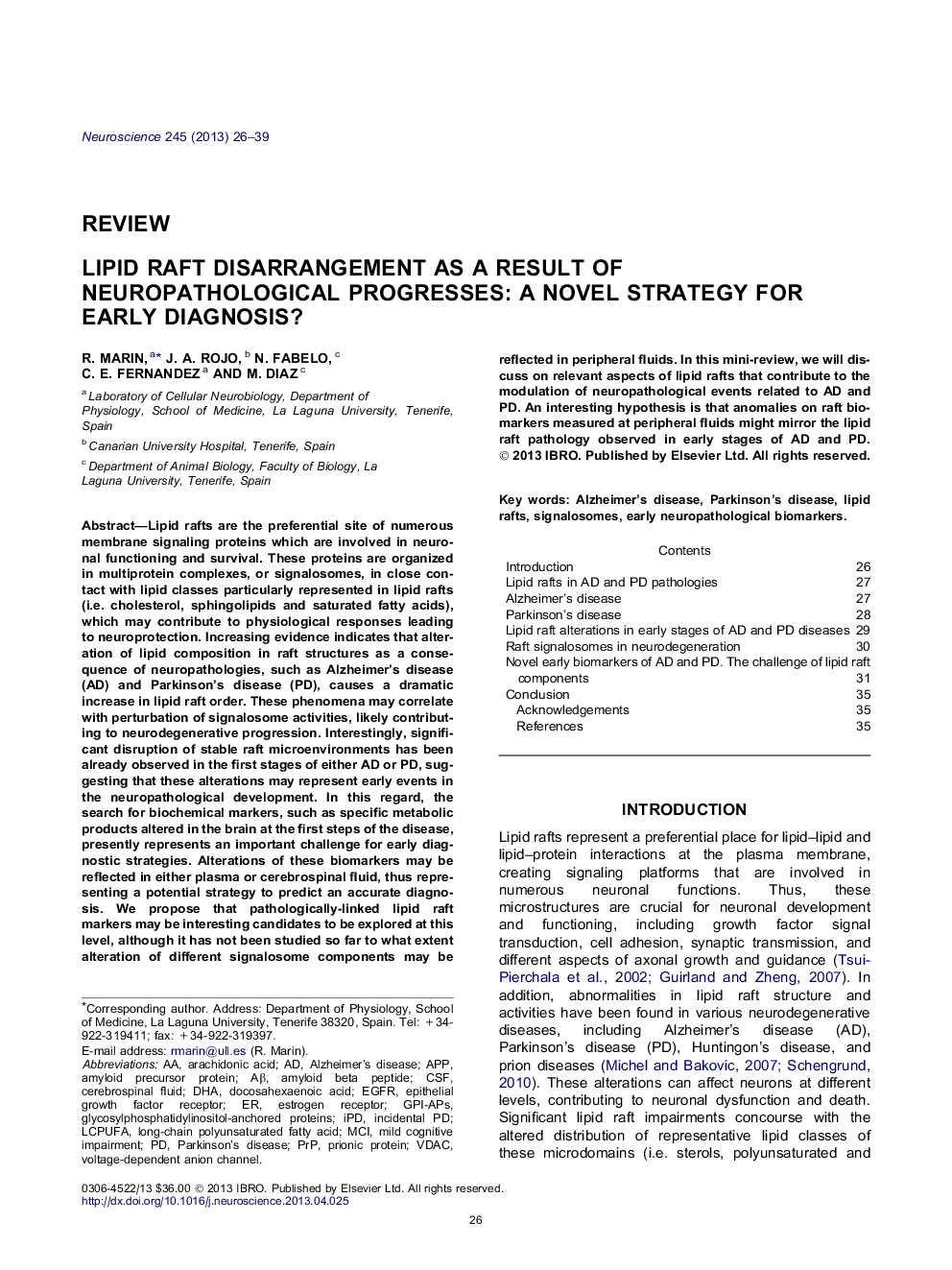| کد مقاله | کد نشریه | سال انتشار | مقاله انگلیسی | نسخه تمام متن |
|---|---|---|---|---|
| 4337969 | 1614831 | 2013 | 14 صفحه PDF | دانلود رایگان |

• We have observed early alterations in lipid raft composition in neurodegeneration.
• We have identified raft-integrated signaling proteins involved in neuroprotection.
• Neuroprotective signaling responses depend on the appropriated lipid raft structure.
• Altered levels of raft-related proteins are detected in cerebrospinal fluids.
• Detection of raft proteins in peripheral fluids could be used as early biomarkers.
Lipid rafts are the preferential site of numerous membrane signaling proteins which are involved in neuronal functioning and survival. These proteins are organized in multiprotein complexes, or signalosomes, in close contact with lipid classes particularly represented in lipid rafts (i.e. cholesterol, sphingolipids and saturated fatty acids), which may contribute to physiological responses leading to neuroprotection. Increasing evidence indicates that alteration of lipid composition in raft structures as a consequence of neuropathologies, such as Alzheimer’s disease (AD) and Parkinson’s disease (PD), causes a dramatic increase in lipid raft order. These phenomena may correlate with perturbation of signalosome activities, likely contributing to neurodegenerative progression. Interestingly, significant disruption of stable raft microenvironments has been already observed in the first stages of either AD or PD, suggesting that these alterations may represent early events in the neuropathological development. In this regard, the search for biochemical markers, such as specific metabolic products altered in the brain at the first steps of the disease, presently represents an important challenge for early diagnostic strategies. Alterations of these biomarkers may be reflected in either plasma or cerebrospinal fluid, thus representing a potential strategy to predict an accurate diagnosis. We propose that pathologically-linked lipid raft markers may be interesting candidates to be explored at this level, although it has not been studied so far to what extent alteration of different signalosome components may be reflected in peripheral fluids. In this mini-review, we will discuss on relevant aspects of lipid rafts that contribute to the modulation of neuropathological events related to AD and PD. An interesting hypothesis is that anomalies on raft biomarkers measured at peripheral fluids might mirror the lipid raft pathology observed in early stages of AD and PD.
Lipid raft constituents as biomarkers for neurodegenerative diseases. Neuronal and glial lipid rafts may be damaged by different physical, chemical and genetic factors during the development of neuropathological processes. Disruption of lipid rafts releases specific subsets of proteins and lipids integrated in these microdomains toward the brain parenchyma. These lipid raft-associated molecules include resident proteins such as caveolin-1 and signalosome interacting proteins including growth factor receptors such as IGF-1R and BDNF, ion channels such as VDAC and NMDA receptor, glycosylphosphatidylinositol-anchored proteins (GPI-APs) such as prionic protein (PrP) and tyrosine kinases of the Src family, among other proteins. Also lipids may be released toward the surrounding parenchyma from lipid rafts. Because of their high concentration in lipid rafts, cholesterol and sphingolipids (including sulfatides and cerebrosides), but also ceramides, which are formed upon catabolism of certain sphingolipids, are particularly accumulated upon disruption of these microdomains. Although less represented in lipid rafts, long-chain polyunsaturated fatty acids (LCPUFA) are important molecules in the progression of oxidative damage given their high susceptibility for oxidation, thus releasing active endoperoxides isoprostanes and neuroprostanes into the brain parenchyma. These raft-derived molecules, proteins and lipids, are poured out for elimination into the cerebrospinal fluid across the ependymal cell layer, or may be released out of the brain through the blood–brain barrier across the endothelial lining to the blood. Accurate measurements of these raft components and by-products in, either CSF or blood, using multivariate approaches such discriminant function analyses may provide a diagnostic tool for the more accurate identification of the type of neurodegenerative disease and its progression.Figure optionsDownload high-quality image (104 K)Download as PowerPoint slide
Journal: Neuroscience - Volume 245, 15 August 2013, Pages 26–39